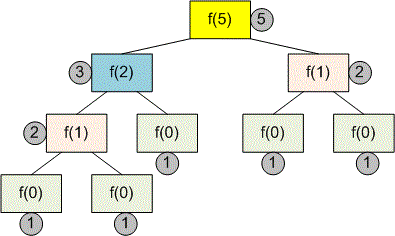Redaksiya
Due to the limitation of , it is impossible to use a linear array to store the results of the function . Therefore, we'll use a map data structure.
Example
Consider the process of computing the function for :

Algorithm realization
Declare a map to store the function values: .
map<long long, long long> m;
Implement the function f.
long long f(long long n)
{
if (n == 0) return 1;
if (m.count(n) > 0) return m[n];
return m[n] = f(n / 2) + f(n / 3);
}The main part of the program. Read the input value of . Compute and print the value of the function .
scanf("%lld", &n);
res = f(n);
printf("%lld\n", res);Java realization
import java.util.*;
public class Main
{
static Map<Long, Long> m = new HashMap<Long, Long>();
static long n;
public static long f(long n)
{
if (n == 0) return 1;
if (m.containsKey(n)) return m.get(n);
long res = f(n/2) + f(n/3);
m.put(n,res);
return res;
}
public static void main(String[] args)
{
Scanner con = new Scanner(System.in);
n = con.nextLong();
System.out.println(f(n));
con.close();
}
}Python realization
Declare a vocabulary to store the function values: .
m = {}Implement the function f.
def f(n):
if n == 0:
return 1
if n in m:
return m[n]
m[n] = f(n // 2) + f(n // 3)
return m[n]The main part of the program. Read the input value of . Compute and print the value of the function .
n = int(input()) res = f(n) print(res)